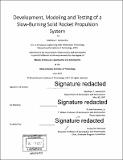Development, modeling and testing of a slow-burning solid rocket propulsion system
Author(s)
Vernacchia, Matthew T
DownloadFull printable version (41.16Mb)
Other Contributors
Massachusetts Institute of Technology. Department of Aeronautics and Astronautics.
Advisor
R. John Hansman, Jr.
Terms of use
Metadata
Show full item recordAbstract
Small, unmanned aerial vehicles (UAVs) are expanding the capabilities of aircraft systems. However, a gap exists in the size and capability of aircraft: no aircraft smaller than 10 kilograms are capable of flight faster than 100 meters per second. A small, fast aircraft requires a propulsion system which is both miniature and high-power, requirements which current UAV propulsion technologies do not meet. To meet this need, a slow-burning solid rocket motor has been developed. Such motors require slow-burning solid propellants with tailorable burn rate. This thesis reports experimental results and combustion theory for a slow-burning solid propellant. It also describes a rocket motor designed to use this propellant, and the manufacturing process used to produce it. This propellant burns slowly enough for the low-thrust, long-endurance needs of UAV propulsion. Its burn rate can be predictably tailored by addition of the burn rate suppressant oxamide. Further, this thesis presents a concept for a small, fast aircraft designed around this novel propulsion technology. The motor integrates elegantly into the aircraft's structure, and compact thermal protection system insulates other vehicle systems from the heat of combustion. These results demonstrate the feasibility slow-burning rocket propulsion systems, and their application to small aircraft. It should be possible for small, rocket-propelled UAVs to sustain powered, transonic flight for several minutes. With this technology, kilogram-scale UAVs could be able to quickly deploy over tens of kilometers, and fly joint missions alongside manned fighter jets.
Description
Thesis: S.M., Massachusetts Institute of Technology, Department of Aeronautics and Astronautics, 2017. Cataloged from PDF version of thesis. Includes bibliographical references (pages 163-168).
Date issued
2017Department
Massachusetts Institute of Technology. Department of Aeronautics and AstronauticsPublisher
Massachusetts Institute of Technology
Keywords
Aeronautics and Astronautics.